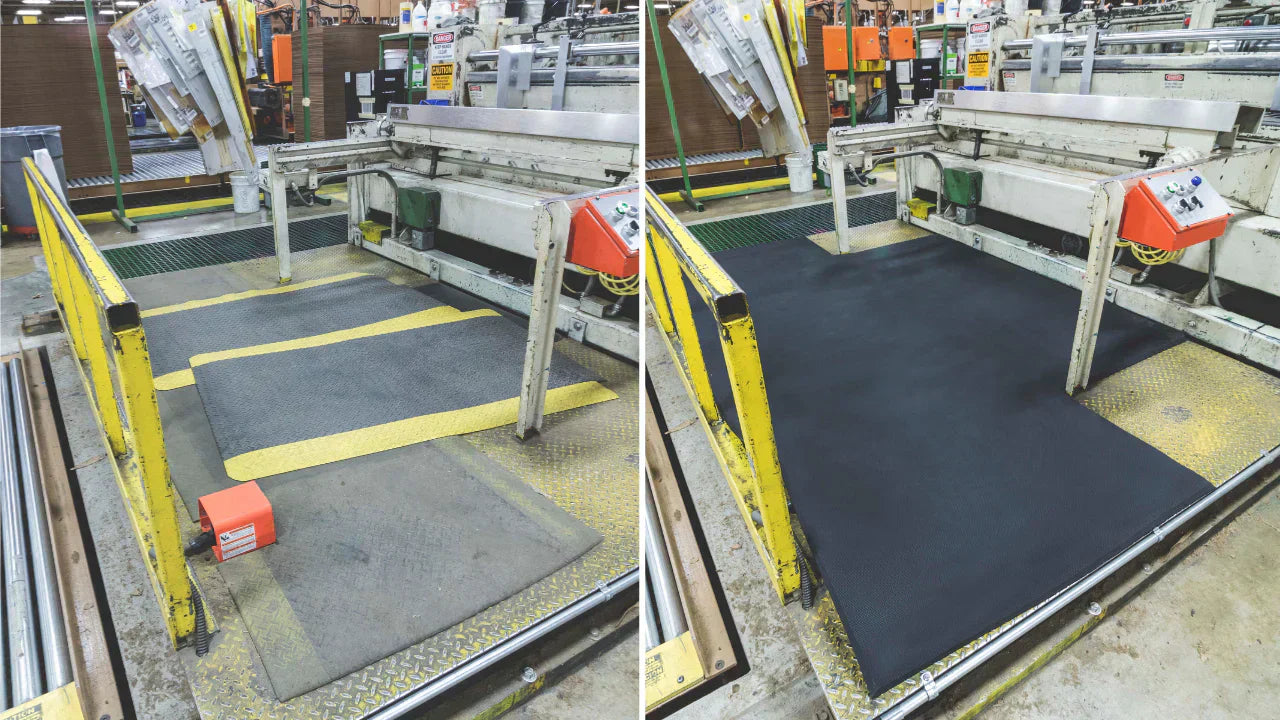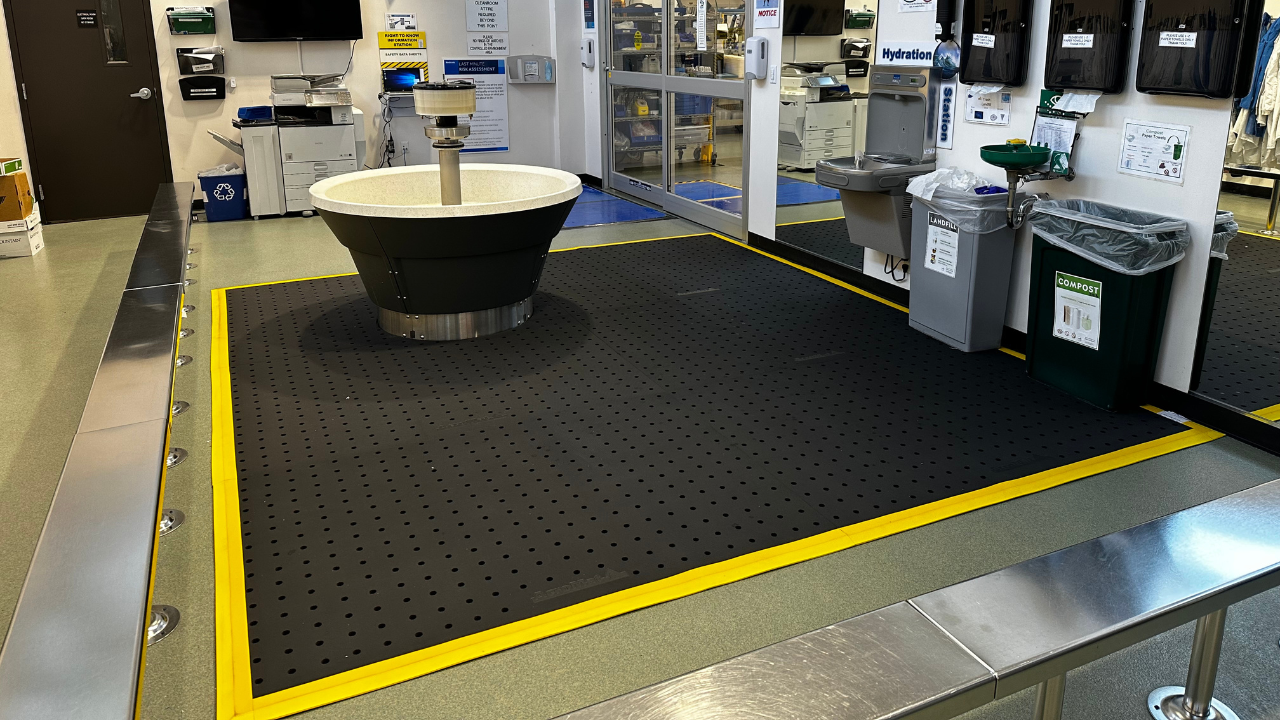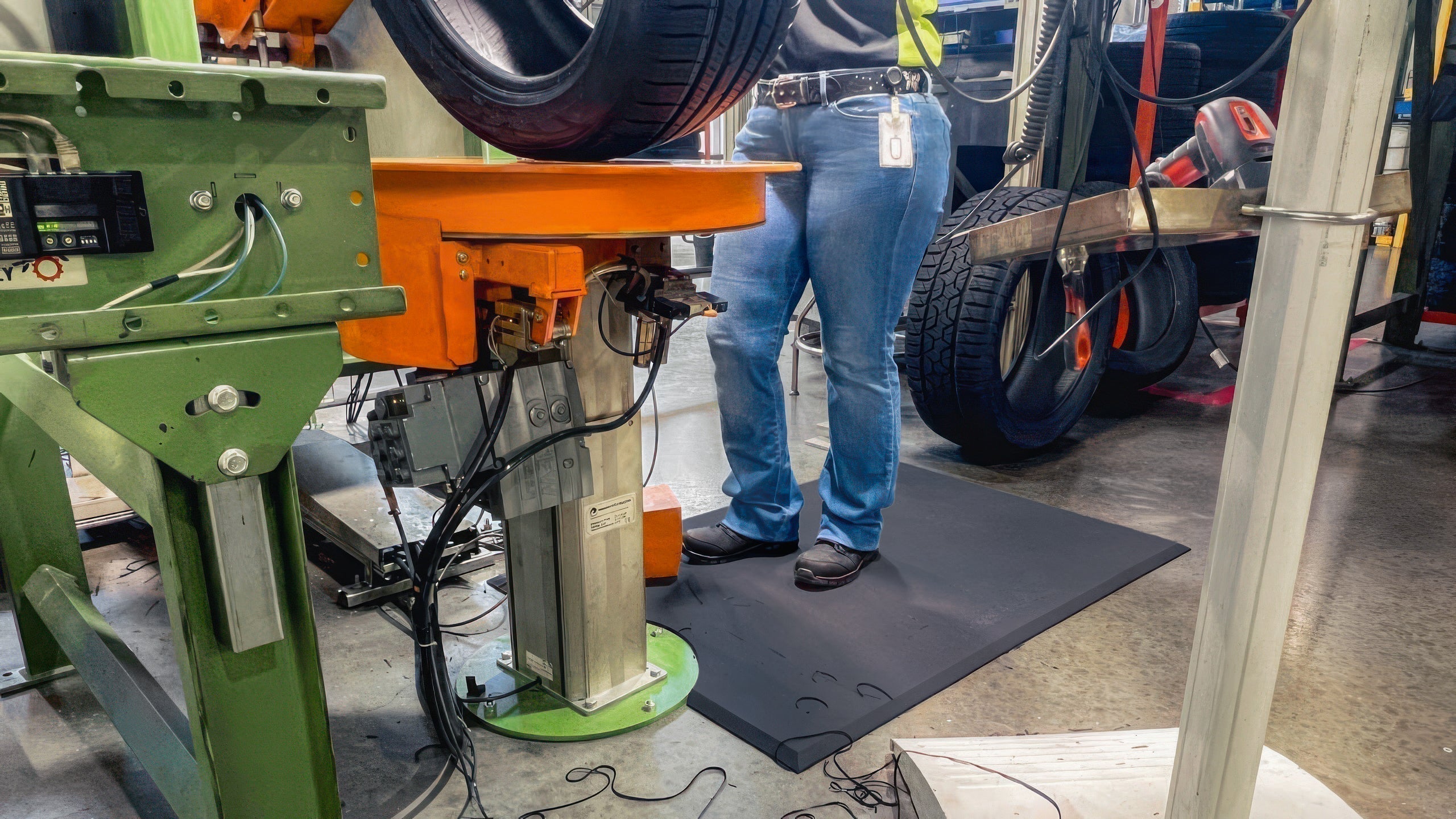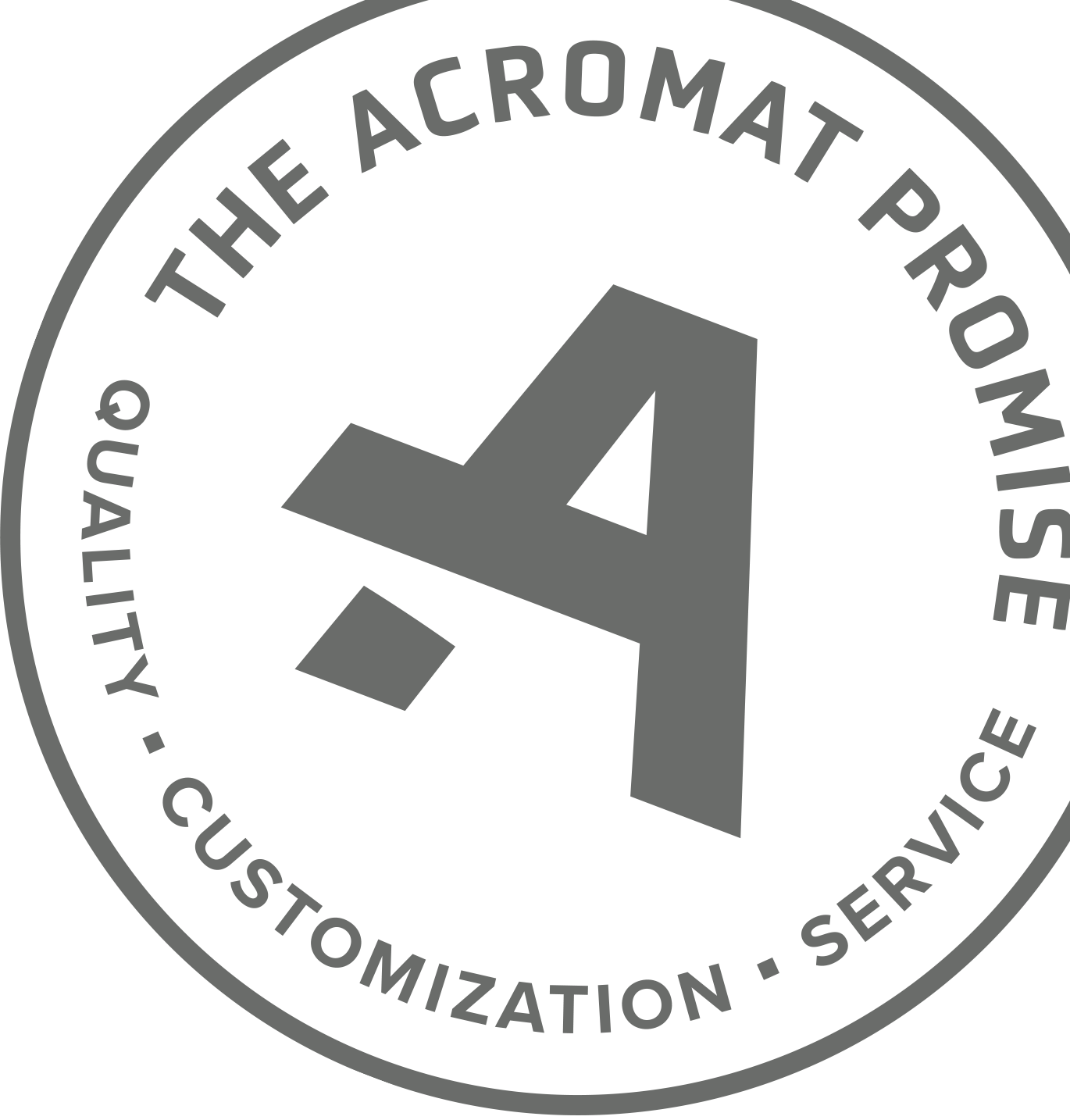Would you benefit from anti-fatigue mats, or would they only get in the way? Here are 5 reasons you need anti-fatigue mats – followed by 3 reasons your team may be better supported by a different ergonomic solution.
Workers Stand for Extended Periods of Time
Cement is unforgiving, metal grating even more so, especially for workers who put in 8-10 hours a shift and primarily stand, bend, and lift. Premium anti-fatigue mats reduce joint impact, support posture and blood flow, and are simply more comfortable than a hard surface.
The anti-slip properties reduce slipping hazards on top of the mat and prevent mats from sliding in areas where sawdust and other particles may build up underneath.
 This custom 100-1 Series anti-fatigue mat for Andersen Windows is made from pure nitrile, closed cell rubber foam. The material naturally adheres to the floor, eliminating any risk of sliding, and will not lose its ergonomic cushion, ever.
This custom 100-1 Series anti-fatigue mat for Andersen Windows is made from pure nitrile, closed cell rubber foam. The material naturally adheres to the floor, eliminating any risk of sliding, and will not lose its ergonomic cushion, ever.
Impacts of Extended Standing
Standing for long periods of time on hard surfaces can reduce blood flow which accelerates fatigue and causes pain in the leg, back and muscles – the main muscles used to maintain an upright position. Over time, this can lead to musculoskeletal disorders (MSDs), including:
- Arthritis
- Rotator cuff strains
- Tendonitis
- Sciatic nerve issues
- Plantar fasciitis
- Shin splints
- Back pain
- Shin splints
- Back pain
According to the National Institute for Occupational Safety and Health, there is a direct connection between work environment and the development of MSDs.
 Limited to rectangular mats, a facility for Crown Holdings previously had exposed harsh and slippery flooring, as well as mat designs prone to curling.
Limited to rectangular mats, a facility for Crown Holdings previously had exposed harsh and slippery flooring, as well as mat designs prone to curling.
 Crown designed a one-piece custom anti-fatigue mat to cover the entire work area with non-slip support, providing critical ergonomic comfort for workers who stand long hours and move back and forth across the cell.
Crown designed a one-piece custom anti-fatigue mat to cover the entire work area with non-slip support, providing critical ergonomic comfort for workers who stand long hours and move back and forth across the cell.
2. Turnover is High
According to the Society of Human Resource Management, replacing an employee who quits costs a company 6-9 months of that worker's salary. An employee making $50,000 a year who suddenly leaves would result in $25-37,000 in lost production, recruitment, onboarding, and training costs.
With 900,000+ open manufacturing jobs right now, a number estimated to jump to 2.1 million within 5 years, workers have options and are being selective. They’re leaving places that don’t fit their personal and professional needs, and they’re staying at places that do.
Unsafe and unseemly work environments, areas with high demands that make production difficult, areas with clearly present safety and employee health hazards – they all play a role in your ability to find and keep the workers you need.
Does your warehouse draw in new recruits or turn them away?
Does your lab make workers feel safe and their health valued?
Are plant workers standing on hard surfaces for 8+ hours a day?
Are there hazards in your factory like raised cable covers or old mats with tears, broken borders, and harmful particle build up?
If turnover is high, recruitment is a challenge and you answer yes to any of the questions above, anti-fatigue mats may be a worthwhile investment.
 Another location within the Crown Holdings facility.
Another location within the Crown Holdings facility.
 This custom one-piece anti-fatigue mat covers the entire area, fitting like a glove to prevent sliding, and also has cutouts to precisely wrap around the various stands and staircase in the area.
This custom one-piece anti-fatigue mat covers the entire area, fitting like a glove to prevent sliding, and also has cutouts to precisely wrap around the various stands and staircase in the area.
3. Safety is a Continuous Challenge
Safety plays a key role in every facet of manufacturing. Safety initiatives improve productivity by keeping workers at work. They reduce workers’ compensation costs and legal risks. And they support recruitment, morale, and engagement by showing workers you care about sending them home safely to their families.
Premium anti-fatigue mats reduce tripping, falling, and slipping. Custom anti-fatigue mats that wrap around equipment and cover entire areas even more so. The AcroMat mats explored above are also antimicrobial, meaning they prevent growth of harmful bacteria like viruses, mold, fungi and other allergens that can make employees sick or compromise your product. They are impervious to fluids, preventing harmful chemicals from soaking into the mats.
4. Absenteeism Threatens Productivity
Absenteeism in manufacturing is 3.1 according to the Bureau of Labor Statistics. In an industry with 16 million workers, this means nearly 500,000 full-time workers are working less than 35 hours a week due to injury, illness, or medical problems.
As touched on above, anti-fatigue mats support worker health and safety in a number of ways. This improves avoidable absenteeism and supports overall productivity in a field that hinges on worker availability.
 You don't need anti-fatigue mats. You need the right anti-fatigue mats. On the left, stacked mats creating a trip hazard and ergonomic inconsistencies. On the right, a single custom mat designed precisely to fit, eliminating all health and safety risks.
You don't need anti-fatigue mats. You need the right anti-fatigue mats. On the left, stacked mats creating a trip hazard and ergonomic inconsistencies. On the right, a single custom mat designed precisely to fit, eliminating all health and safety risks.
5. Tight Budgets
Insoles last for a few months, requiring frequent purchases. They also leave with the employee when there's turnover. Modular tiles break apart easily and take hours to install. PVC anti-fatigue mats last 6-12 months while PVC/nitrile mats last 1-3 years. All of the above require frequent product searches and re-purchases that get in the way of production.
100% nitrile anti-fatigue mats, like the AcroMat 100-1, 100-ESD, and 100-Cleanroom Series last up to 8 years. They don't curl or flatten over time, and can be restored and extended without having to buy new. In brief, premium mats save exponential costs year over year.
If experiencing any of the challenges above, anti-fatigue mats offer a valuable option – not just in terms of health and safety, but in terms of long-term cost savings, recruitment, morale, and productivity.
Related: Winnebago Saves $150,000 with Custom Anti-Fatigue Mats
3 Reasons You Don’t Need Anti-Fatigue Mats
As an anti-fatigue mat manufacturer, we’re biased. We've seen them elevate manufacturing companies and their workforces in countless areas. Yet, here are 3 reasons a different ergonomic solution may fit better.
I. You Have a Highly Mobile Workforce
If you have workers who move back-and-forth across a large facility, anti-fatigue mats may not be the most cost-efficient option. In this instance, custom orthopedic insoles – which are significantly more expensive but go beyond the 4-month lifespan of lower-quality insoles – may better serve your employees.
II. Your Workforce Mostly Sits
If your teams sit for 90% of the day and you have a limited budget, ergonomic chairs should perhaps be the first investment. Heavy equipment and chairs can also damage ergonomic mats if rested on them for extended periods of time.
 This pharmaceutical manufacturer designed custom cutouts with 20-degree, ADA-compliant yellow borders into their ergo mat. As workers balance sitting and standing 50-50, this mat provides the perfect middle ground for health and safety.
This pharmaceutical manufacturer designed custom cutouts with 20-degree, ADA-compliant yellow borders into their ergo mat. As workers balance sitting and standing 50-50, this mat provides the perfect middle ground for health and safety.
III. Your Workforce Mostly Drives
If your teams mostly drive forklifts like side loaders, walkie stackers or order pickers, anti-fatigue mats may be more of an obstacle than asset. Ultimately, it's important to evaluate your workspace, what your employees need, and the ergonomic and safety solutions available.
--
Design the custom anti-fatigue mat you need in minutes with AcroSketch, the only tool of its kind. Any shape and size without limit.
Interested in learning more? Need a hand designing the right mat? Book a few minutes with our team! Let’s walk through it all together.






